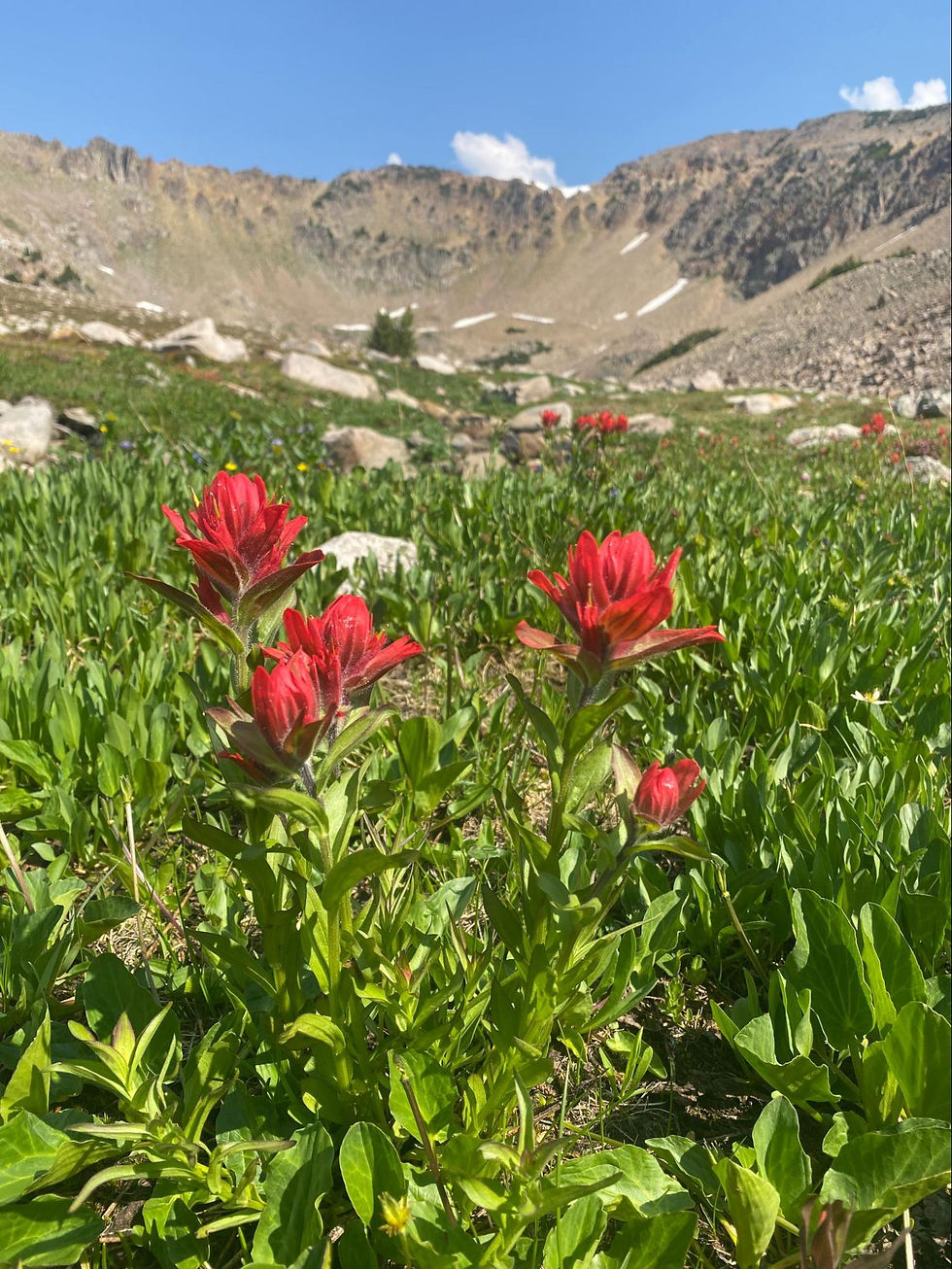Reflections from a Solitude Monitor
- WWA Staff
- Nov 4, 2024
- 3 min read
Three wildernesses, 5 trailheads, 14 monitoring zones, 22 outings, 5 overnights, and over 300 miles traveled on the trail this summer all in the name of solitude monitoring. The main chunk of my time was spent in the Bridger Wilderness across three trailheads and four monitoring zones per trailhead with each zone requiring a weekend and weekday monitoring session.

Several people asked if I got bored hiking the same trails multiple times, but I found a deep appreciation for hiking the same chunk of trail over and over. The people you meet on the trail are never the same. The weather is different. Some wildflowers die as others are just blooming. Change in the time of day creates varied light and shadows. There were times I was hiking alone and other times I brought along a friend or family member. And you never know when or where wildlife will make an appearance.
Whether you are looking for solitude or a social outing, the wilderness of Wyoming has something for everyone. There were times that I didn’t encounter a single person in my four hours monitoring a zone and other times that I saw 15 groups in 15 minutes. However, even at the busiest trailheads, I still found it easy to veer off the trail just a few hundred feet to a nice, flat, snack rock with a stunning view and leave the bustle of the trail behind me.
Although there were several times that I went hours without encountering another human, there were few times that signs of others before me weren’t apparent. Even in the most remote zones with no trail on the map, I often came across a user trail leading to the next lake, a fire ring, a cairn, or a piece of trash (that I’d stoop down to pick up) reminding me that I was not the first person to come through here.

One of my favorite moments in the wilderness this summer came from a trip into the most remote zone monitored at one of the trailheads. I was not looking forward to this trek as googling the area brought up zero trip reports and the only trail on the map was an unmaintained trail that ended at the wilderness boundary where my monitoring began. And while I don’t mind a trailless rock hop to a summit or a romp through an alpine meadow, my least favorite mode of transportation in the wilderness is bushwhacking through a forest. However, as I reached the wilderness boundary, I was pleased to see what seemed to be a well-worn boot path continuing through the meadow. As I continued to follow the trail, I realized that there were, in fact, no boot prints at all. Instead, all I found were elk tracks and elk scat. I could hardly walk 10 steps without encountering another dropping. I wasn’t on a well-worn booth path at all, but I was following an elk trail. So when the meadow came to the edge of a forest - a Bridger Wilderness-type forest with no shortage of blown down trees - I felt at ease following the trail. I knew that it wasn’t some amateur bushwhacker who had bumbled through to make the straightest shot from point A to point B, but I was following an elk who was much larger than me, not prone to scrambling above and weaving through multiple downed trees, and who knew this forest much better than I or anyone ever would.
I have always said that trail builders are some of my favorite people. I am grateful for the organizations and agencies that currently steward our incredible wilderness. I am grateful for the people who stewarded this land long before there were established wilderness, forest, and state boundaries. And while I’m still grateful for all of those groups, in that moment, I was grateful for the elk that shared their home with me and provided an easy route through a thick, and blow-down strewn forest.

Wyoming Wilderness Association is always looking for solitude monitoring volunteers. With four wildernesses and multiple zones within each wilderness, there is bound to be a trail that is right for you. We still have an upcoming training on Monday, September 2nd at Elkhart Park. We’d love for you to join us!






At Interiors by Harriet, we’re committed to keeping you happy by offering the best in window décor design and cleaning services. Our experts will work with you to choose products that suit your unique style and complement your existing décor. We’ll create a captivating room full of enchanting details that make your character stand out.
Play the latest and greatest games for free – SteamUnlocked! https://steamunlocked.com.ru/
Generally speaking, if you receive the proper instruction, writing tasks is easy. If you're not interested in paying someone to complete your project, you can get sample homework assignments for free at assignment help online service. On their website, you may find over 500 assignment samples on a range of topics, all produced by their qualified assignment assistants and experts from all over the world. Specifically, you can use the examples of paperwork that have been included below to figure out how to write appropriately formatted assignment papers in accordance with the guidelines provided by your supervisor.
Booking a ride with Lake Sunrise Shuttle is simple and efficient. The service offers online reservations, allowing passengers to secure their spot in advance. Many travelers appreciate the ease of digital booking https://morainelakesunriseshuttle.com/ which eliminates the need for last-minute arrangements.
Claims denials and rejections are common challenges in behavioral health RCM. Denials occur due to incorrect patient information, coding errors, or missing documentation. Providers best behavioral health emr must establish a structured process for identifying and addressing denials.